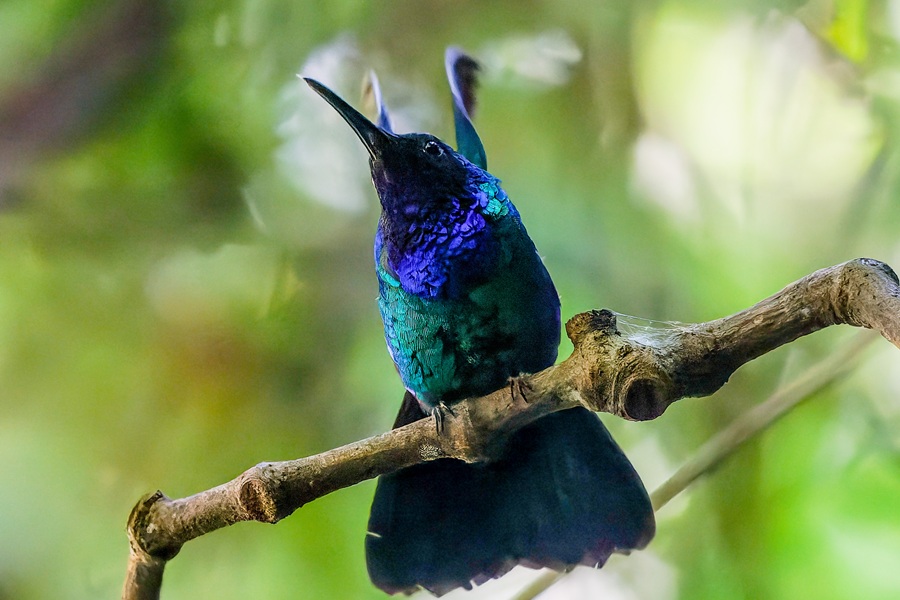Colombia: Santa Marta & Eastern Andes
This tour covers all accessible Santa Marta and Perija endemics (including the recently rediscovered Perija Parakeet and Santa Marta Sabrewing), along with many more specialties of the eastern Andes as we drive south to Bogotá. Green-bearded Helmetcrest, Chestnut-bellied Hummingbird, Recurve-billed Bushbird, Niceforo's Wren, Mountain Grackle, Vermillion Cardinal, and Bogota Rail all feature in this exciting itinerary!
Next Dates
10 January - 24 January 2026 (15 days)
Leaders:
Joachim Bertrands
Group Size Limit:
6
Single Room Supplement: $
500 USD
Deposit: $
750 USD
Price: $
7200 USD
24 January - 28 January 2026 (5 days)
Leaders:
Joachim Bertrands
Group Size Limit:
6
Single Room Supplement: $
300 USD
Deposit: $
750 USD
Price: $
1900 USD
Bogotá Extension
Accommodation:
Good to very good throughout. Note that at some ProAves lodges with limited rooms, singles are not possible.
Walking difficulty:
Easy to moderate throughout the tour on a mixture of trails and roadside birding.
Tour cost includes:
All accommodation, main meals, drinking water, internal flights (as stated in itinerary), overland transport, tips to local drivers and guides, travel permits, entrance fees, and guide fees.
Tour cost excludes:
Flights before and after the tour start/end, visa, travel insurance, tips to tour leaders, laundry, drinks, and other items of a personal nature.


Day 1: The tour commences at Barranquilla International Airport (BAQ) in the evening, from where we drive to our nearby hotel, have an introductory dinner, and get excited about the adventure to come!
Day 2: This morning, we will visit the University of Atlántico campus; one of the better sites to see the scarce endemic Chestnut-winged Chachalaca. We will have a first introduction to the avifauna of northern Colombia, with likely species including Glaucous Tanager, Pale-bellied Hermit, Bicoloured and Stripe-backed Wren, and many more. Next stop will be at the Salamanca Island Road Park in search of one of Colombia’s rarest hummingbirds: the Sapphire-bellied Hummingbird! We will also look for Sapphire-throated Hummingbird, Chestnut Piculet, the striking Black-crested Antshrike (here of the streak-fronted form), and Stripe-backed Wren. We will also visit the Ciénaga Grande de Santa Marta, where will we look for Dwarf Cuckoo and the huge Northern Screamer, our first Russet-throated Puffbird, Turquoise-winged Parrotlet, Sapphire-throated and Shining-green Hummingbirds, Black-collared Hawk, Bronze-brown Cowbird (recently elevated to species level from Bronze Cowbird), and many waterbirds. Night in Minca, in the lower part of the Sierra Nevada de Santa Marta.
Day 3-4: We will proceed towards the fabled Sierra Nevada de Santa Marta, stopping first at low elevation to look for scarce Coppery and Red-billed Emeralds, the beautiful Black-backed Antshrike, monotypic and weird Rosy Thrush-Tanager, Scaled Piculet, smart Golden-winged Sparrow, and many more. We will drive uphill to our accommodation for the next two nights: the great Mountain Lodge, situated very close to most of the endemics!
We will have the possibility to explore the upper reaches of the Sierra Nevada de Santa Marta, home to an impressive number of endemic and near-endemic species. We will target every possible endemic species and subspecies (only three Santa Marta endemics require expeditions to get to, but we will do our best to find all the others). While Hermit Wood Wren, Santa Marta Brushfinch, Santa Marta Antbird, Sierra Nevada Antpitta, Santa Marta Mountain Tanager, Rusty-headed and Streak-capped Spinetails, White-tailed Starfrontlet, Santa Marta and White-lored Warblers, Yellow-crowned Whitestarts, and Brown-rumped and Santa Marta Tapaculos are reasonably common, other endemics like Santa Marta Parakeet, Santa Marta Screech Owl, Santa Marta Blossomcrown, Santa Marta Woodstar, Black-backed Thornbill, Santa Marta Foliage-gleaner, Santa Marta Antpitta, and Santa Marta Bush-Tyrant usually require more luck and persistence. We will also be looking for some other species (either endemic forms, near-endemics or localised birds) like Black-fronted Wood-Quail, exquisite White-tipped Quetzal, Yellow-billed and White-throated Toucanets (the latter of a distinctive endemic form), Sooty-capped Hermit, Rusty-breasted Antpitta, Golden-breasted Fruiteater, Black-hooded Thrush, and the local forms of Grey-throated Leaftosser and Black-banded Woodcreeper. Nights at Mountain Lodge.
Day 5: After some final birding, we will leave the Sierra Nevada behind and drive north-east to reach the arid Guajira peninsula, home of several endemics shared with nearby Venezuela. We will make some stops en route to look for some previously missed species of lower elevations and maybe some mammals like the beautiful Cotton-top Tamarin. With a great deal of luck, we might even find the locally very rare Lilac-tailed Parrotlet. Night in Riohacha.
Day 6: We will travel early in the morning to Los Flamencos National Park. We will be exploring various xerophytic habitats and stretches of La Guajira, where our prime targets will be regional endemics such as Rufous-vented Chachalaca, Green-rumped Parrotlet, the amazing Vermillion Cardinal, stunning Orinoco Saltator, White-whiskered Spinetail, Buffy Hummingbird, Tocuyo Sparrow, and Chestnut Piculet. More widespread but interesting species could include Bare-eyed Pigeon, Caribbean Hornero, Slender-billed and Pale-tipped Inezias, Black-backed Antshrike, and many more. We will then have a fairly long drive south to Valledupar, where we will spend one night.
Day 7: Quite an exciting morning as we will become some of the first birders to see the recently rediscovered Santa Marta Sabrewing. Until this new site became accessible, it had not been recorded since 2010! We will spend the rest of the day heading towards Serrania del Perijá, doing some initial birding in the area when we arrive this afternoon for a three night stay. Night in Serrania del Perijá.
Day 8-9: Two full days birding the Serrania del Perijá, a mountain range adjacent to the Sierra Nevada de Santa Marta marking the border with Venezuela. It holds several interesting endemics found nowhere else, but is only safely accessible on the Colombian side! We will begin our exploration of this area by finding the localised Rufous-shafted Woodstar and Klages’s Antbird, plus our first Perija endemics such as the secretive Perija Brushfinch. Higher stretches of the Serrania del Perijá can be particularly exciting, with lots of specialties to be found! These include Perija Thistletail, Perija Metaltail, Perija Antpitta, Perija Tapaculo, and some yet-to-be-split species such as “Black-fronted” Yellow-breasted Brushfinch and “Perija” Golden-bellied Starfrontlet. We might well find other localised species like Black-fronted Wood Quail, Spectacled and Coopman’s Tyrannulets or Fulvous-headed Tanager, amongst others. We also stand a chance at finding Buff-fronted Owl, a major rarity in Colombia which we discovered here on our last tour! Nights in Serrania del Perijá.
Day 10: This morning, we will drive back down the hills and start our drive south. After five hours, we will reach the southern stretches of the Perija mountains near La Jagua de Ibirico, where we will go uphill a little to reach a local farm where the highly distinctive Todd’s (or Perija) Parakeet was recently rediscovered. The locals have been aware of it for many years, but the news only came to a birder’s ears recently! We will spend a few hours birding at this locality and enjoying great views of this striking, endangered parakeet. We will also have a second chance at species like Rosy Thrush Tanager. We will then continue southwards to reach Ocaña, where we will overnight.
Day 11: The main reason to visit the remote locality of Ocaña is the nearby Recurve-billed Bushbird Reserve protecting habitat for what is one of the world's rarest antbirds, the Recurve-billed Bushbird. We will spend the morning exploring trails through bamboo forest in the hope of locating a pair of these spectacular and endangered antbirds, which we have a good chance of finding. There are quite a few other birds at this locality that are difficult to find elsewhere in Colombia, and we might well find one or two specialties like Grey-throated Warbler, Klages’s Antbird, Chestnut-bellied Thrush, Black-headed Tanager, Moustached Puffbird, or Moustached Brushfinch. We will then start the longish drive (seven hours) to San Vincente de Chucuri, where we will stay for the next two nights.
Day 12: Full day birding at Cerulean Warbler Reserve in the town of San Vicente de Chucuri and bordering the Yariguíes National Park. Here, we can observe Cerulean Warbler of course, but we will also look for Niceforo’s Wren, Gorgeted Wood-Quail, White-bellied Antpitta, White-mantled Barbet, Turquoise Dacnis, Beautiful Woodpecker, Magdalena Tapaculo, Parker’s Antbird, Indigo-capped Hummingbird, Yellow-throated Spadebill, among many more. Nights in San Vincente de Chucuri.
Day 13: We will have a final morning of birding around the Cerulean Warbler reserve, with an extra effort to locate the localised Chestnut-bellied Hummingbird, before making our way towards Bucaramanga for an overnight stay.
Day 14: We will leave Bucaramanga behind and travel southwards, making stops for Apical Flycatcher, Golden-winged Sparrow (here of an isolated subspecies), Spectacled Parrotlet and a few more, before reaching Rogitama Biodiversity reserve, where we will overnight. Feeders here attract a huge array of hummingbirds like Lazuline Sabrewing, the endemic Black Inca, Golden-bellied Starfrontlet, Longuemare's Sunangel and more widespread species. At night we will look for White-throated Screech Owl.
Day 15: We will start very early this morning to reach some patches of cloudforest and paramo above the town of Duitama, where we will look for the endemic Colombian Mountain Grackle and Rusty-faced Parrot, as well as Pale-bellied Tapaculo, Black-headed Hemispingus and Rufous-browed Conebill. We will then visit a site for "Colombian" Horned Lark, before driving to Bogota where the tour ends this evening.
BOGOTÁ EXTENSION
Day 1: Overnight near Bogotá International Airport after concluding the main tour.
Day 2: Departing early, we will travel to Chingaza National Park and nearby places, where we will spend all morning looking for Brown-breasted Parakeet, Muisca Antpitta, Longuemare’s Sunangel, Coppery-bellied Puffleg, Black-billed Mountain Toucan, Rufous-browed Conebill, Pale-bellied Tapaculo, and many more. In the afternoon, we will visit the Hummingbird Observatory, with opportunities to photograph Black-tailed Trainbearer, Amethyst-throated Sunangel, Glowing Puffleg, Sword-billed Hummingbird, Green-tailed Trainbearer, Coppery-bellied Puffleg, Tyrian Metaltail, Great Sapphirewing, and Blue-throated Starfrontlet at point blank range. Night in Bogotá.
Day 3: This morning, we will travel to Sumapaz National Park, where we have good chances to see Green-bearded Helmetcrest, Silvery-throated Spinetail, Apolinar’s Wren, Northern Tawny Antpitta, Tawny-rumped Tyrannulet, and Andean Tit-Spinetail. During the day, we will also visit the Chicaque Nature Reserve, where we will look for Tourmaline Sunangel, White-bellied Woodstar, Lesser Violetear, Mountain Velvetbrest, Pale-edged Flycatcher, Flame-faced Tanager, Black-capped Tanager, and Beryl-spangled Tanager. Night in Bogotá.
Day 4: Very early in the morning, we will travel to the east of the city of Bogotá to visit the Cundinamarca Antpitta Reserve. After several hours of travel, we will look for Cundinamarca Antpitta, Slate-crowned Antpitta, and Chestnut-crowned Antpitta. We return to our hotel in the afternoon ahead of our final night in Bogotá.
Day 5: After a morning around Bogotá in search of Bogota Rail, we will transfer to the airport, where the tour ends this afternoon.
This tour perfectly complements our other itineraries in this wonderful country!






















.jpg)




